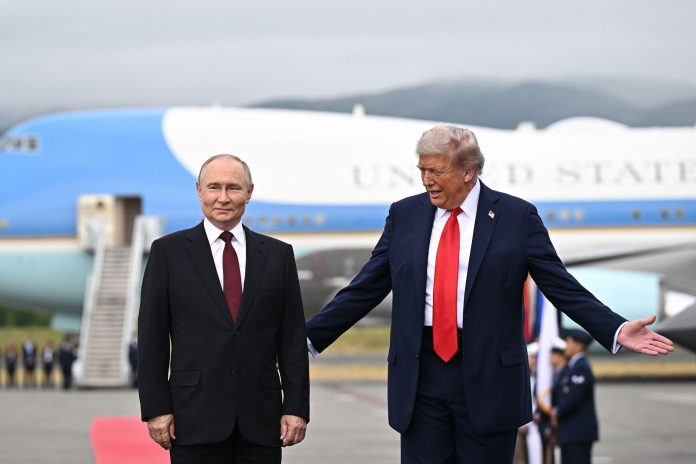The long-anticipated meeting between US President Donald Trump and Russian President Vladimir Putin in Anchorage has generated widespread debate across global media. While the summit was framed as an opportunity to address the conflict in Ukraine, it concluded without a formal ceasefire or major breakthrough. Instead, the coverage has largely focused on the tone of the encounter, the optics of the leaders’ interaction, and the possible implications for future negotiations.
Warm welcome for Putin
Many outlets highlighted the unexpectedly cordial atmosphere surrounding the meeting. The New York Times described the summit as a diplomatic success for Putin, who, after years of strained relations with the West, appeared to step out of isolation. Trump welcomed him with a red-carpet reception, a joint appearance on the runway, and even a short ride together in the US president’s limousine.
The Washington Post also underlined the warmth of the encounter, contrasting it with Trump’s earlier treatment of Ukrainian President Volodymyr Zelenskyy at the White House. Images of the leaders smiling, shaking hands and watching a fly-past of American aircraft were widely circulated in Russian media, where they were presented as proof that Putin had been received as an equal partner by the United States.
European commentators, however, expressed unease at the optics. The Guardian noted that Putin seemed to dominate the press conference, setting the tone by addressing journalists first. The Economist and Financial Times both drew attention to the contrast between Trump’s leniency towards Putin and his confrontational approach to Zelenskyy earlier in the year.
Lack of concrete results
One of the central criticisms raised by Western outlets was the absence of a concrete outcome on Ukraine. Sky News reported that hopes for a ceasefire were quickly dashed, as neither leader mentioned it in their statements. Similarly, Der Spiegel observed that expectations had already been low, but even so the meeting “produced more questions than answers”.
Trump stated that progress had been made, though without elaborating. He later told Fox News that he and Putin had agreed on “most issues except one or two”, and called on Ukraine to “make a deal”. According to Reuters, Putin proposed freezing the front lines in exchange for Ukrainian withdrawal from certain territories, but there was no formal agreement. The shift in language from “ceasefire” to “peace agreement” was widely noted as aligning more closely with Russian objectives.
International responses
Western leaders and analysts expressed concern over the lack of substance. Critics in Washington argued that Trump had offered concessions without securing meaningful commitments from Moscow. Former US officials, quoted by CNN and Politico, warned that Putin had secured a symbolic victory: he avoided further sanctions, faced no public criticism over military actions in Ukraine, and left the summit with the prospect of future talks.
European responses were similarly cautious. Commentators in Corriere della Sera described the visit as historically significant, noting that it was Putin’s first on US soil in a decade, but stressed that the talks yielded little. French daily Le Figaro underlined the unusually close rapport between the two leaders, calling their relationship “unique in modern US–Russia history”.
India’s Times of India struck a more optimistic note, suggesting that while no final deal was reached, the emphasis on dialogue signalled that the “door to peace remains open”. Chinese agency Xinhua echoed this view, but also questioned the symbolism of the American military display that accompanied the visit.
Reaction from Ukraine and Europe
Ukrainian officials responded with concern to the lack of clear commitments. The New York Times reported that Kyiv had awaited the joint statement anxiously, only to conclude that the war would continue at the same intensity. European leaders, including figures in Germany and the European Commission, have since reaffirmed support for Ukraine’s sovereignty and voiced opposition to any agreement that would force territorial concessions.
Zelenskyy is due to meet Trump in Washington in the coming days. According to The Guardian, this visit will be used to press for firm security guarantees and to ensure Ukraine remains central to any negotiations.
Perceptions of winners and losers
Across the media landscape, assessments varied but most agreed that Putin gained more than Trump from the summit. Analysts cited by NBC News and Financial Times described the event as a “victory” for the Russian leader: he returned home without new sanctions, avoided commitments to halt military operations, and regained international visibility as a negotiating partner.
Trump’s cautious performance was seen as unusual by outlets such as The Guardian, which remarked that he left “more questions than answers”. His emphasis on optimism and the promise of further talks did little to dispel criticism that the meeting lacked depth.
The Trump–Putin summit in Alaska was marked more by its symbolism than by its substance. While both leaders spoke of progress and the importance of continued dialogue, the absence of concrete agreements has fuelled scepticism in Western capitals. For Putin, the meeting provided valuable international recognition and the opportunity to present himself as an equal to the US president. For Trump, it offered a stage to argue for a negotiated settlement, though critics contend that his approach risks sidelining Ukraine.
As the focus now shifts to Trump’s upcoming meeting with Zelenskyy, attention remains on whether the optimism expressed in Anchorage can be translated into tangible steps towards ending the conflict.
